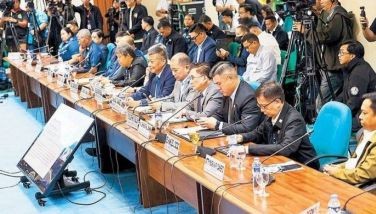Print a house
How would you like to build a house in just a few days, fabricate any spare part for your car or machine, make a prosthetic leg or even a set of false teeth. You can even produce food without having to work on the farm.
Welcome to the world of 3D printing, a.k.a. Additive Manufacturing, which builds things layer by layer from 3-dimensional (3D) model data usually generated by a computer-aided design (CAD) software. The model is sliced into many layers and then printed using a 3D printing machine.
The most common 3D printing technology is the Fused Filament Fabrication, which is similar to the principle of a glue gun where a plastic filament is fed through a heating element and is extruded through a nozzle. A computer program controls how the 3D printer fabricates the item, one layer at a time.
Depending on the application, different types of materials are used, including polymers, metals, concrete, ceramics and composites/nanocomposites. Natural polymers in the form of bio-inks like gelatins are used for 3D bioprinting.
The applications of 3D printing are varied and wide-ranging. For example, the 3D printing of food for customized nutrition and for those with difficulty in swallowing can help address widespread hunger. Corals may also be 3D-printed and coral reefs rehabilitated. Pipes, fittings, filters and membranes can be produced for water purification and desalination.
One of the most important aspects of 3D printing is for medical applications, including prosthesis, dentures, orthodontic models, bone replacement, organ bioprinting, as well as protective equipment for medical workers. When there was limited supply of PPEs during the early days of the COVID-19 pandemic, 3D printing facilities produced PPEs such as face shields, ear guards, mask flanges, venturi valves, spare parts needed in hospitals and even isolation wards.
More importantly, 3D printing reduces manufacturing inputs, energy, wastes and carbon dioxide emissions, addressing issues on sustainability, environmental degradation and climate change.
Filipinos are beginning to appreciate this game-changing technology, thanks to the efforts of the Department of Science and Technology (DOST) and its partner agencies. DOST has established several 3D printing research facilities, the first of which is the Additive Manufacturing Research Laboratory at the Bataan Peninsula State University (BPSU) in Balanga City, Bataan. The second and largest one is the Advanced Manufacturing Center (AMCen) at the Metals Industry Research and Development Center at DOST in Taguig.
With DOST-AMCen’s advanced manufacturing facilities, the Philippines leapfrogs over most of its ASEAN neighbors in 3D printing capabilities. Last Dec. 30, DOST-AMCen unveiled the 12.5-foot Rizal the Filipino Scientist monument, the first 3D-printed monument in the Philippines, at the DOST compound in Bicutan, Taguig.
BPSU, through a project funded by DOST-3, uses hybrid manufacturing, i.e., 3D printing and traditional bamboo manufacturing, to increase manufacturing capabilities and add value to bamboo-based products. Soon, a research project in collaboration with the University of Technology Sydney will focus on the development of solar-driven desalination with 3D-printed absorbers for clean water production, a technology that will benefit people living in islands and remote areas.
Recently, BPSU signed a Memorandum of Understanding with the Provincial Government of Bataan, the Philippine-American Academy of Science and Engineering, the National Resilience Council, DOST-III and the Carlos P. Romulo Foundation for Peace and Development to establish the Bataan Advanced Science and Technology Ecosystem for Sustainable Development. One project to be undertaken aims to establish the first 3D-printed village in the country. This will show how institutions can converge and work together on programs adopting S&T for sustainable development.
The Department of Trade and Industry (DTI) has also been providing 3D printing facilities through its Shared Service Facilities, i.e., Fabrication Laboratories or Fab Labs. These facilities are platforms where academe, industry and government can collaborate and enable MSMEs to develop new products and generate new streams of income. Aside from product development, some Fab Labs support the packaging and labelling needs of local businesses.
DOST has been sending researchers to the Advincula Research Group in the United States to undergo in-depth training on this technology under the supervision of Professor Rigoberto Advincula. Last year, BPSU hosted the First International Forum on Additive Manufacturing and Advanced Materials, while AMCen hosted the ASEAN Conference on Additive Manufacturing. These initiatives are propelling 3D printing R&D in the country.
With all these initiatives related to 3D printing, we are seeing the rise of the 3D printing technology in the country, both in terms of acceptance and adoption. 3D printing is ushering us towards creative and innovative manufacturing. And with the democratization of this technology, 3D printers will become accessible to everyone and will be a common equipment not only in industry, but also in schools, offices and homes. There are now shops that can print out small objects that make unique and interesting gifts or souvenirs. Soon, anyone will be able to innovate and will be empowered to provide solutions to problems in their local communities.
* * *
John Ryan C. Dizon, Ph.D, is the director of BPSU’s DR3AM Center, the first 3D printing research facility in the Philippines. He is a member of the steering committee of DOST’s AMCen. Email: jrcdizon@bpsu.edu.ph
- Latest
- Trending






























